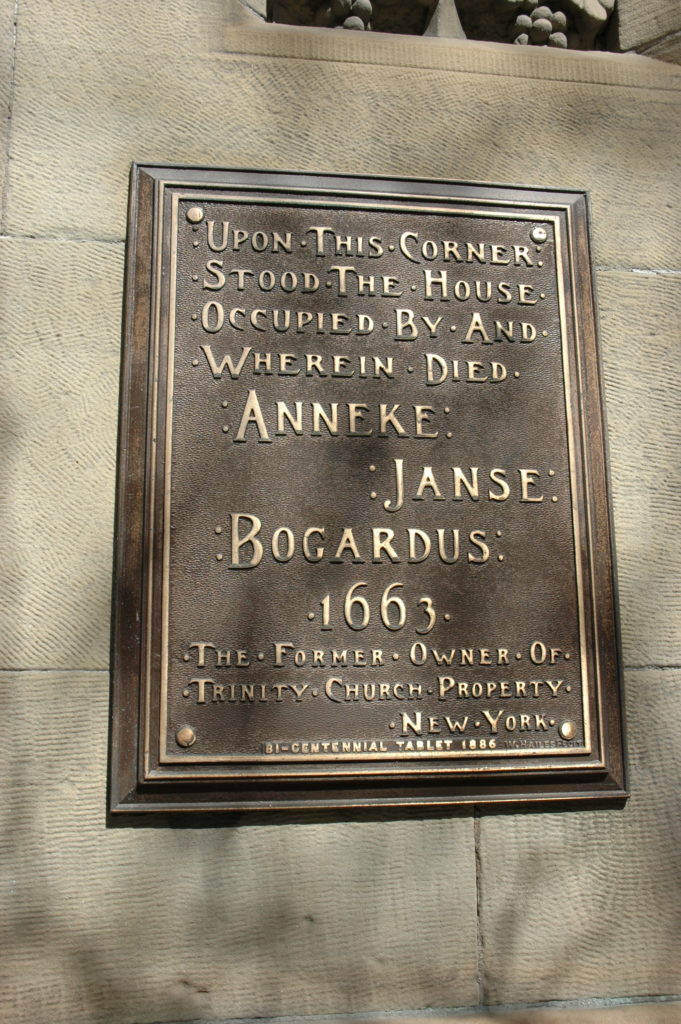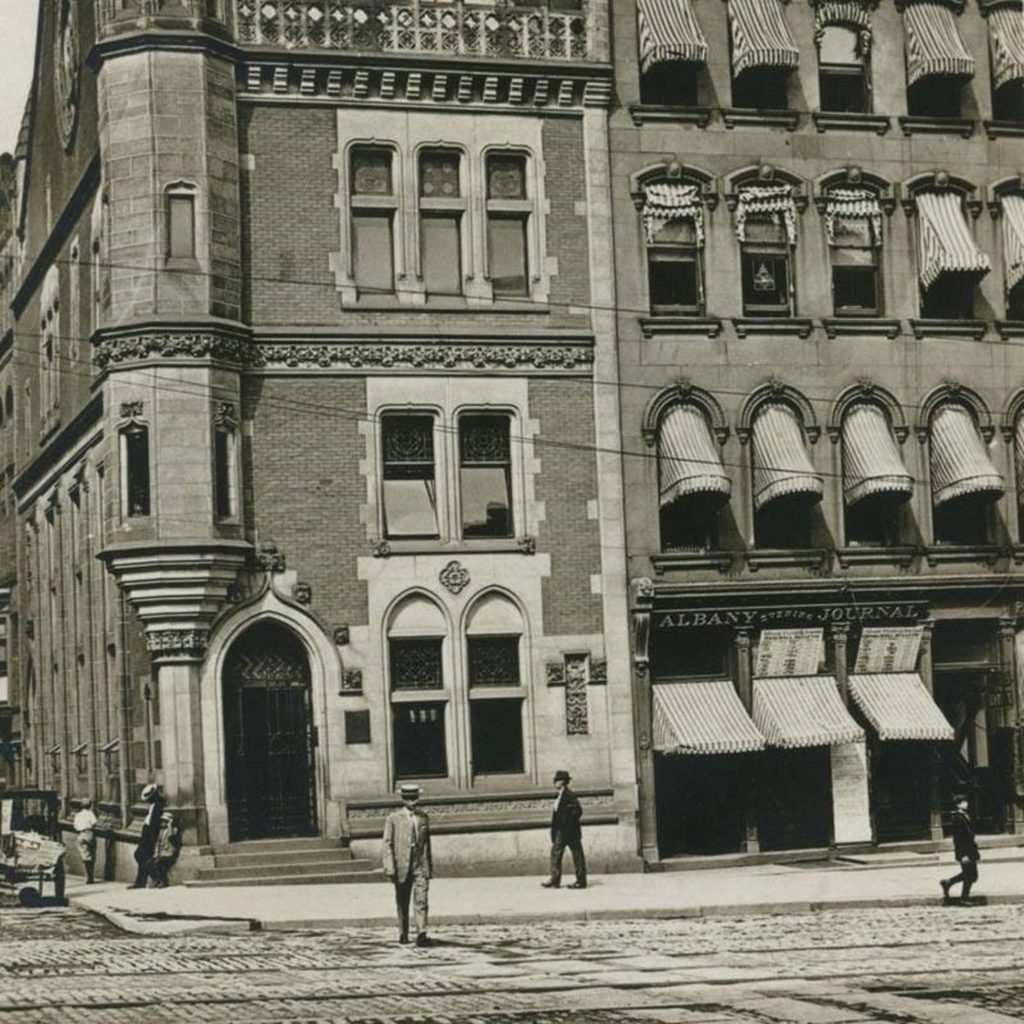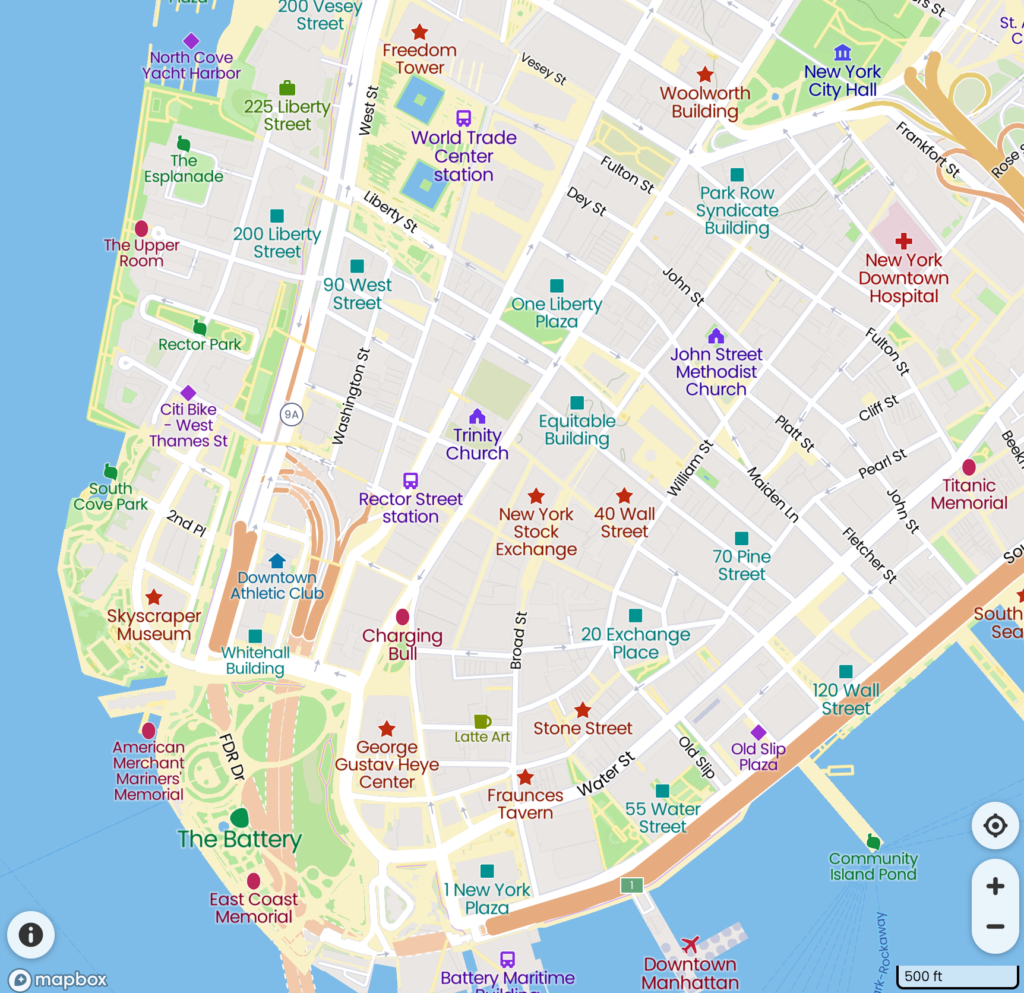Continuing our series on the tablets placed in honor of the bicentennial of Albany’s charter as a city, we have the only tablet honoring a woman.

Tablet No. 13 – Anneke Janse Bogardus
Bronze tablet, 16×22 inches, placed on front door pier of State Street side Farmers and Mechanics’ Bank. Inscription :
“Upon this Corner stood the House Occupied by, and wherein died, Anneke Janse Bogardus, 1663, The Former Owner of Trinity Church Property, New York.”
This beauty, with its distinctive type similar to Tablet No. 2, still stands in its original location, on what had been the the Mechanics and Farmers Bank (the description above, from the Bicentennial Committee on Monumenting and Decoration in 1886, got the bank’s name backward). Personal names used to be much more fluid, both in context and spelling, than they are now. Anneke’s first name is sometimes given as Annetje. Her maiden name may have been Jans, but she may also have adapted the surname from her first husband. Today most sources refer to her as Anneke Jans Bogardus.
Anneke herself is a bit of a cipher – not unusual for women of her day, unfortunately. Various sources give her varying parentage and nationality. Some sources give her maiden name as Webber, some do not. Some say she was born in Norway, some say in Holland. One history gives her a connection to the Dutch royal family, saying she was the grand-daughter of William the Silent through a clandestine marriage and a son christened Wolfert Webber. One such is the 1924 work of Thomas Bentley Wikoff, in “Anneke Jans Bogardus and her New Amsterdam Estate Past and Present.” The title does go on: “Romance of a Dutch Maiden and Its Present Day New World Sequel – Historical, Legal, Genealogical.” But even Wikoff admits that he could not “verify this tradition with facts,” and most sources discard any royal connection as spurious. A book defending Trinity Church’s claim on its property against Anneke’s heirs stoops to say that “She was neither herself, nor was either her first or her second husband, very attractive personages.”
All the sources seem to agree that Anneke was born somewhere in 1605, and that her first husband was Roeloff (by a variety of spellings) Jansen, and they all seem to agree that they had several children before they came to New Netherlands in 1630, among the first of Kiliaen Van Rensselaer’s settlers. Roeloff apparently had a three-year contract to farm, and there are reports that they worked De Laet’s Burgh, only slightly later known as Greenbush, which was where the Patroon first sought to concentrate his colonists, across the river from the West India Company’s Fort Orange. (It seems likely that the Roeliff Jansen Kill in Columbia and Dutchess counties is named for some other Roeliff or Roeloff Jansen.)
There has been some dispute as to the national origins of Roeloff and Anneke, given that they sailed from the Netherlands and the ridiculous rumors that she was of Dutch royalty. “Scandinavian Immigrants in New York, 1630-1674,” by John O. Evjen, argues that Roeloff Jansen was from Norway and so, by extension, was Anneke. It cites A.T.F. van Laer, once the State Archivist, who concluded that they were from Marstrand, a small coastal island that belonged to Norway prior to 1658, and also that Roeloff farmed at de Laets Burgh with two others who were known to have come from Norway, Claes Claesen and Jacob Goyversen.
It is reported that they had not much success with farming in this remote outpost, and moved to New Amsterdam when the term of the original contract was up, where Roeloff and Anneke were granted 62 acres from the Dutch West India Company, under Director General Wouter Van Twiller. Roeloff died in 1637, leaving Anneke and four children. (There is, of course, some dispute, but it would appear they were daughters Sarah, Catrina, and Fytje, and son Jan Roeloffson.)
After Roeloff died, Kiliaen Van Rensselaer released her from her debts to the Patroon; writing to his director Wouter van Twiller, “My reason for so doing I will tell you orally, when we meet, God willing, in good health.” Not only was she released from her debts, she was allowed to participate in the fur trade.
Anneke soon married Dominie Everardus Bogardus, a minister and schoolmaster who had come to New Amsterdam in 1633 from Holland. Together they also acquired something like 130 acres in the area of Hunter’s Point, which they leased out. The couple had four more children: William Bogardus (1638), Everardus (died in infancy); another Fytje; and Annetje.
Evjen’s book also offers the only personal story of Anneke we have, by way of Lamb’s “History of the City of New York.” It says that Anneke, as the wife of the Dominie Bogardus, “went to pay a friendly visit to a neighbor; but on getting into the ‘entry,’ discovered that Greitje Reinirs, a woman of questionable reputation, was in the house, and thereupon turned about and went home. Grietje [sic] was greatly offended at this ‘snubbing’ from the Dominie’s lady , and followed her, making disagreeable remarks. While passing a blacksmith’s shop, where the road was muddy, Mrs. Bogardus raised her dress a little, and Grietje was very invidious in her criticisms. The Dominie thought fit to make an example of her,” and brought suit against Grietje’s husband for his church dues, for which he was in arrears.
Wikoff asserts that Dominie Bogardus had a complaint against the new Director General Kieft (probably regarding his pay), and in those days, bringing a complaint required sailing back to Holland. And so Bogardus did in 1647, but his ship foundered and he was one of several who drowned, which left Anneke a widow again. The tracts of land were confirmed as hers in 1652. In 1657, she sold a house (probably the parsonage) near the Battery, but continued to own the remaining land. Shortly after Bogardus’s death, Anneke moved back to Beverwyck, or Albany (Dominie Megapolensis wrote about it in 1648, in pleading for some assistance she may have received), and bought a lot adjoined by two of her sons by Bogardus, building the house where she died in 1663. (She was buried in the Dutch church or the church yard, mere feet from her house; she’s now at Albany Rural Cemetery.)
Anneke’s Estate
Her estate at the time considered of household furniture at Albany, her apparel and jewelry, the 130 acre farm at modern Hunter’s Point (then called Dominie’s Hoeck), an 84-acre farm on Long Island near Hallett’s Point, and the original 62-acre farm on Manhattan known as the “Dominie’s Bowery.” Yes, she owned it all, but her second husband got all the naming credit.
Her will was written and dated January 29, 1663. In it she names: daughter Sarah Roeloffson, wife of Hans Kierstead; Catherine (Catrina) Roeloffson, wife of Johannes Van Brugh; Fytje Roeloffson’s children Jannetje and Rachel Hartgers; son Jan Roeloffson; and her sons by Bogardus — Wilhelm, Cornelius, Johannes (Jonas) and Pieter.
Her four first born children, those from Jan Roeloff, were to divide one thousand guilders to be paid from the proceeds of the farm on Manhattan Island. Three of them had “received certain donations” at the time of their marriage, but unmarried Jan had not, so he was to receive a bed and milch cow. Johannes and Pieter Bogardus were given a house and lot in Beverwyck that was west of her own house, as well as a bed and milch cow each. And she gave silver mugs to several grandchildren.
The Albany house on Yonkers Street (later State), later the location of the Merchants and Farmers Bank building that still stands, was sold by her heirs to Dirk Wesselse Ten Broeck for 1,000 guilders in beavers. How many beavers was that exactly (or even roughly)? Well, first we have to understand that guilders weren’t really being expressed as Dutch coinage but instead as equivalent amounts of wampum or seawan, and there were different types or qualities of wampum. (There’s an in-depth discussion at this website.) But for our purposes, let’s say that in 1673, 24 guilders of wampum (which included 2880 beads if white, and 1440 if black) was worth one beaver. So that would mean the Albany property was sold for about 42 beaver pelts.

In 1670, Anneke’s heirs sold the Manhattan farm, known as the Dominie’s Bowery, to the colonial governor, Colonel Francis Lovelace. However, one of her original heirs, Cornelius, had died in 1666, leaving a widow, Helena Teller Bogardus, and an infant son, Cornelius Bogardus. No one representing the interests of the widow or child signed the conveyance of the property to Lovelace . . . and so began the claim by descendants of Cornelius, rejected many times, against the property that eventually was granted to Trinity Church.

Again, we’re sorry to say that none of this sheds any light on Anneke herself. Stephen Nash, in his defense of Trinity, goes so far as to say that “The period, too, in which [Anneke and Roeloff] lived has a very meagre interest, except for students of the early Colonial history.” There could hardly be anything more interesting than someone who made the decision to leave Europe for what was then truly an untamed wilderness, who moved down and then back up the river, outlived two husbands, raised some number of children, and somehow set off centuries of legal disputes. But it says a lot about historical views of women that she would not be noted or remembered had she not been in a position as a Dutch woman to hold title to property (a right generally not allowed to English women) that her heirs and a church could fight over for a few centuries. Even Wikoff’s book, purportedly about Anneke, gives us no information about her that isn’t in relation to her marriages or her children.
The history of the plot of land she owned at what is now the corner of State Street and James Street is unclear up until the time the present structure was constructed on it.
The Mechanics and Farmers Bank was incorporated in 1811, and originally housed on the north side of State Street, just north of Broadway. In 1813, it moved to 6 Court Street (Broadway) in a house occupied by Ford’s carpet store. That was replaced by a handsome, domed marble building in 1814 on the corner of Court and Exchange, on what later became the site of the Government Building. The bank was run for decades by the Olcott family; it was Thomas W. Olcott who bought the Ten Broeck Mansion and renamed it Arbor Hill, though the neighborhood around it already claimed that name. In 1876, the current landmark was created for the bank by architect Russell Sturgis. It wasn’t always a building alone, as shown in this photo from around 1900:

AllOverAlbany reported that the Mechanics and Farmers Bank eventually became the Mechanics and Farmers Savings Bank, which merged with the Albany Exchange Savings Bank as the Mechanics Exchange Savings Bank. In 1972, the bank moved to the renovated Standard Building, owned by New York City developer Abe Hirschfeld, at 112 State Street. (The bank was acquired by Dime Savings Bank in the 1970s, and Dime was acquired by Washington Mutual in 2002.) At the time of the move, it was reported that State Bank of Albany had purchased the Sturgis building, but as the bank owned most of that block and had converted it to parking in the 1950s, it wasn’t expected this little architectural gem would survive. “Most likely, the structure will be torn down after June 1972,” the Knickerbocker News wrote. Yet it did survive, continuing as some bank or another into the late ’80s or early ’90s, then housing the Center for Economic Growth. If you know what goes on there today, drop it in the comments.
Thanks to some commenters here and on Facebook who pointed us to some additional sources for information on Anneke Jans.

Leave a Reply